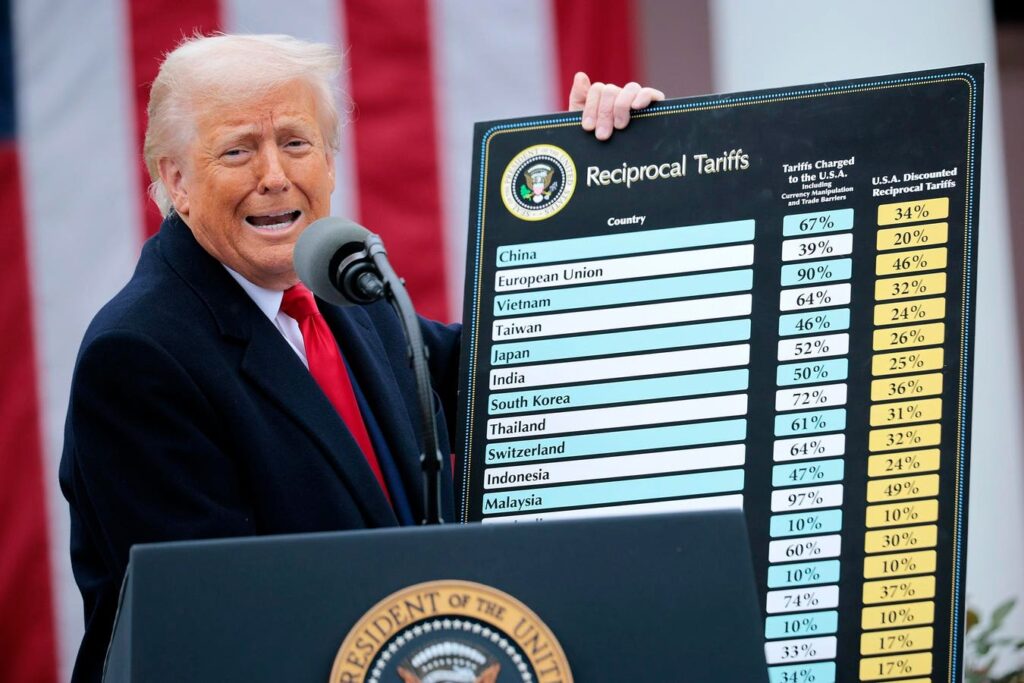April 2025 emerged as a pivotal moment for financial markets, fundamentally reshaping how investors perceive and manage portfolio risk. Marked by unprecedented policy shifts, soaring volatility, and a rare synchronized plunge in stocks and bonds, the month rivaled the chaos of the 2008 global financial crisis and the 2020 COVID-19 crash.
From a historic VIX spike to gold’s unexpected resilience, these events exposed vulnerabilities in traditional diversification strategies and hinted at a potential secular shift in global markets. Here’s a detailed look at what unfolded, why it mattered, and how it redefined risk for investors moving forward.
Liberation Day Ignites Market Chaos
The turmoil began on April 2, 2025, dubbed “Liberation Day,” when President Donald Trump unveiled an ambitious tariff plan with rates as high as 125% on imports from countries like China, as reported by The Associated Press. The proposal, one of the most aggressive trade policies since the Smoot-Hawley Tariff Act of 1930, promised to reshape global trade dynamics.
Volatility surged as Wall Street’s “fear index,” the VIX, soared to levels unseen since the 2008 crisis and 2020 pandemic crash, according to Investopedia, peaking on April 8, 2025. The S&P 500 plummeted 18.9% from its February 2025 high by April 8, while the tech-heavy Nasdaq entered bear market territory, dropping 26.7% from its December 2024 peak by April 7. This rare breakdown in the negative correlation between equities and fixed income upended the risk-mitigation assumptions of diversified portfolios, leaving investors exposed to unprecedented losses.
Compounding the challenge, bonds—typically a safe haven during equity market turmoil—failed to provide relief. The aggressive tariff plan fueled fears of inflation and reduced global demand for U.S. Treasuries, as foreign investors anticipated trade disruptions and higher borrowing costs. This drove yields on the 10-year Treasury note from 4.01% on April 4 to 4.48% by April 11, causing bond prices to plummet and eroding their role as a hedge, before yields settled at 4.23% by April 28.
Why did bonds falter? Foreign governments and central banks, wary of U.S. economic nationalism, appeared to reassess their reliance on U.S. Treasuries. While foreign holdings of U.S. debt rose from $8.527 trillion in January 2025 to $8.817 trillion in February, according to U.S. Treasury Department data, some countries—like China and Russia—accelerated diversification into assets like gold, signaling caution.
Amid the chaos, gold shone as a bright spot. Rallying since November 2024, the precious metal peaked at just over $3,500 on April 22. Driven by demand from institutional investors and central banks, gold’s rally underscored its value as a non-correlated asset that thrives amid geopolitical and economic uncertainty. For portfolios battered by stock and bond losses, gold offered a critical hedge, highlighting its growing relevance in risk-conscious strategies.
A Secular Shift On The Horizon?
The events of April 2025 raise profound questions about the U.S. economy and its role in global markets. The synchronized decline in stocks and bonds has challenged the traditional 60/40 portfolio, forcing investors to rethink diversification. The possibility of reduced global reliance on U.S. assets, evidenced by central bank gold purchases, introduces risks to the dollar’s status as the world’s reserve currency.
As markets head into the typically quieter summer months, uncertainty persists, with tariff implementation details, retaliatory trade measures, and Federal Reserve policy decisions poised to drive volatility. To navigate this new risk environment, investors should consider reallocating to assets less tied to U.S. markets, such as gold for its stability, commodities for inflation protection, or select emerging market equities in countries less exposed to tariff fallout. Hedging currency risk and prioritizing liquidity will also be key as global trade dynamics evolve.
April 2025 will stand as a defining chapter in financial history, not only for its market turmoil but for its profound impact on portfolio risk management. The synchronized collapse of stocks and bonds, coupled with gold’s rise and questions about the dollar’s dominance, has upended conventional investment wisdom.
As uncertainties linger—driven by trade policies, central bank maneuvers, and geopolitical shifts—investors must adapt to a new risk landscape. Diversifying into assets like gold, commodities, or select emerging markets, while closely tracking global developments, will be critical. Whether April’s upheaval marks the dawn of a broader secular shift remains uncertain, but it has undeniably redefined how investors approach risk in an unpredictable world.
Read the full article here











